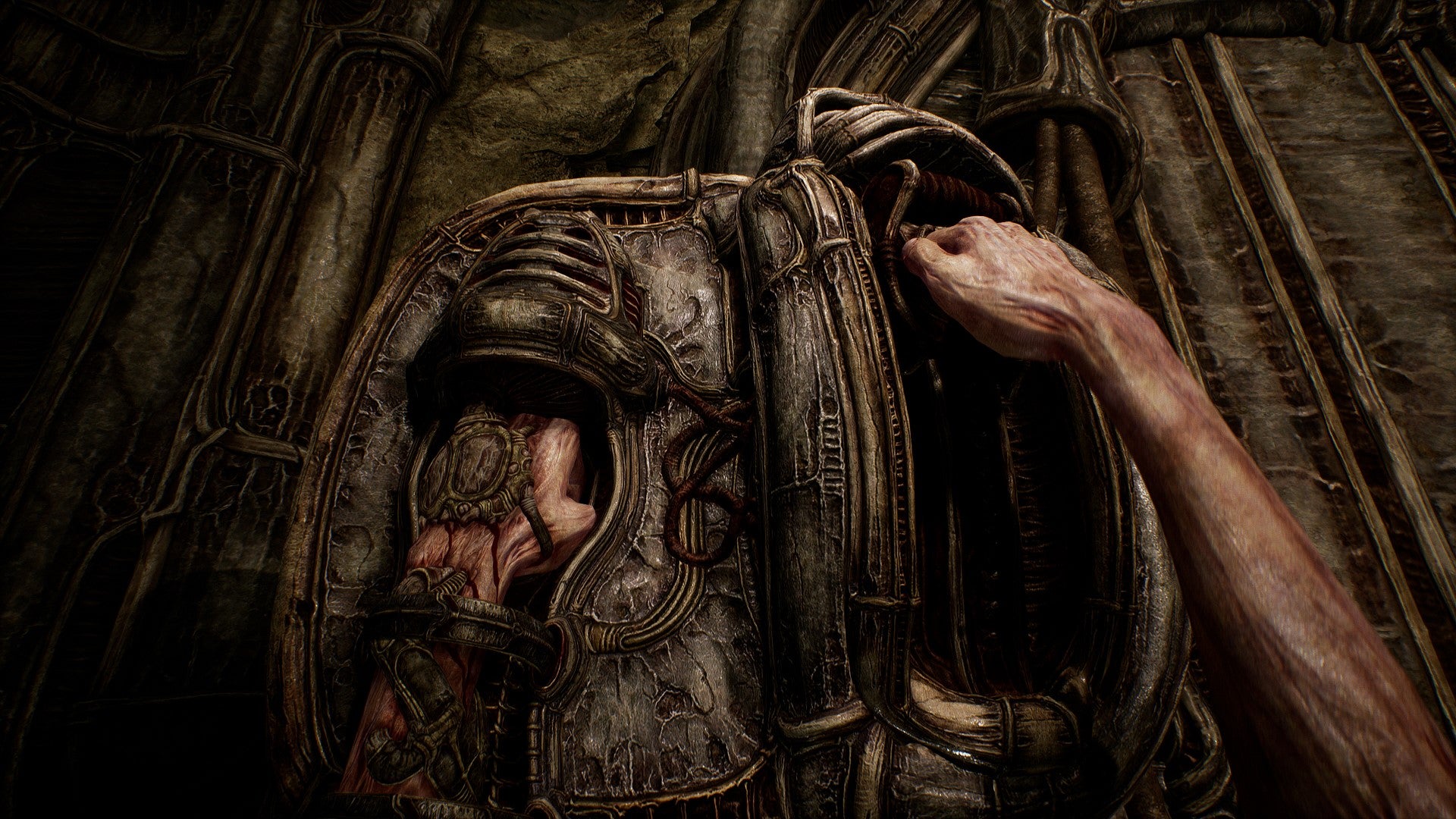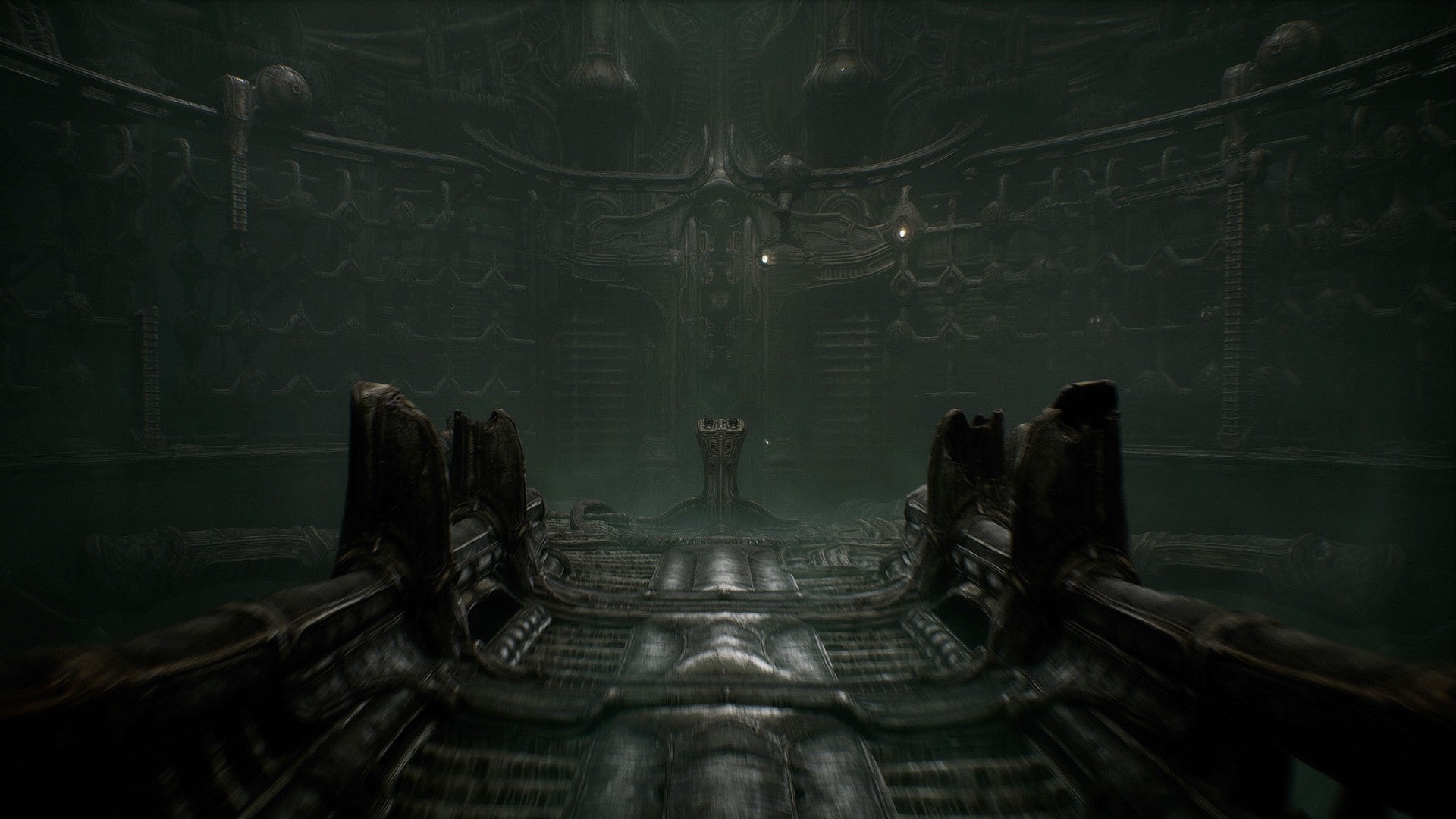Nope - the game wasn’t what I expected at all. At least, not the 45-minute portion I got to play. Rather, my demo was more of a hardcore puzzler with some exploration elements and the teeniest smattering of action. Don’t get me wrong, it was still unsettling and grotesque! Just in more of a brain-training way, if the brain-training was for MIT graduates, or like, the human calculators on University Challenge. Right at the start of the demo, my character – an unfortunate body model – awoke from his slumber and peeled himself from a prison of tubes and bones. He then crawled forwards towards a large pylon of meat as flashbacks of another less meaty tower obscured by a raging sandstorm flickered into view. All went quiet after that rush of noise, and I continued to amble through an eerie facility and, err, take in the sights. At least in the portion of the game I played, Scorn’s flavour of gross wasn’t all flailing limbs and spurts of gunk from walls of screaming heads. And it certainly wasn’t scatological, as surfaces seemed mercifully clean of poo and/or wee. To me, it seemed to be aiming for a more understated body horror where flesh met machine. Or, to put it another way, where each room and corridor felt like a splayed open cyborg. It wasn’t scary per se, but its architecture was unsettling, closely resembling what I’d imagine a space station would look like if a jar of wrinkled dates, a ruptured achilles tendon, and Siri worked on a group project together. But as I skulked further through the game’s metallic intestines, I became increasingly struck by Scorn’s beauty. You might think me a sick man for even suggesting such a thing, but it’s true! Brown murk has never looked so good. When I came across a tangle of tunnels that opened out into this enormous arena, for example, there was a lone spiral staircase in the centre that looked as if it was made from melted iron. If you looked up, you could see light poking its way in (a rarity), with the intricate machinery that adorned its walls stretching upwards into a haze. Whether at a distance or up close, the attention to detail was genuinely ridiculous. Beauty aside, the game’s architectural design governed exploration and the sort of things I’d need to advance through its innards. Without a HUD and objective marker to guide me, I had to rely heavily on directional cues. These started off okay, but gradually petered out into a confusing garble of twists and turns as its spaces grew more complex. For a simpleton like me, the subtle cues were perhaps a bit too subtle for my liking, and I never quite caught on whenever the game was prompting me to move on or come back to something later. For instance, I spent an age rewiring some train tracks atop the melted staircase only for a dev to peer over my shoulder and tell me to move on and explore elsewhere, lest I waste more precious demo time – this happened a lot. While I enjoy figuring things out for myself, I do also like being nudged whenever I’m skipping down the wrong avenue. Scorn wasn’t good at this, namely because a lot of its puzzles intertwine inside its maze-like structure, which itself requires quite a lot of brainpower to untangle. You’re simultaneously battling with your bearings and a mechanism that links to another mechanism down one alleyway, which then leads to another someplace else. That’s not to say that the puzzles themselves weren’t good, but they were sometimes a bit obtuse for their own good. One that particularly sticks in the memory was a hardcore take on a simple playground puzzle, requiring me to free intact eggs from a grid by shifting them all over to one side. It was a mixture of sliding obstacles in the right order so they could all slot into their rightful parking spaces. Its surface level simplicity drew me in initially, but after almost tearing my hair out after what felt like an age, the devs swooped in to figure it out with me. Turned out the egg I freed from the grid puzzle was meant to drop into a pram, which I’d then need to guide using the track trains from the gigantic arena I mentioned earlier. Eventually, it ended in leading this tormented Abe’s Odyssey-looking dude to a terminal and using his arm to unlock a special door. Over and over again, though, the devs hovered over my shoulder to help me out with the process. And I’m certain it wasn’t just my own incompetency, as I heard another journo next to me apologise profusely for his repeated asks for aid. Maybe if you’ve got a mathsy brain you’ll be in your element here, as I bet some of my brainier, more analytically-minded mates would’ve clicked things into place after just a few shifts of the egg. Thing is, Scorn’s early portion clearly didn’t seem to cater for those who weren’t so strong at problem-solving. Difficulty problems aside, though, I will say that upon completion, their effects on Scorn’s wider landscape fed back into the overall structure of the place in a very pleasing way. Pincers sprung to life and snatched pods from crevices. Grates slid upwards with a rumble. I even secured this piston gun that acted more like a tool, letting me interact with yet another puzzle as well as bash hostile flying nasties. But just as I’d encountered my first monster, the demo ended. My time with Scorn was an odd one, as it’s a grim pleasure to immerse myself in its silent basins of pipes and pylons that looked like ribcages and arteries. Yet, its hardcore puzzling mixed with its maze-like structure and deliberate lack of direction may prove too cumbersome for all but the brainiest of puzzle solvers. Still, I’m intrigued to play more of the game when it launches on October 21st, if only to see if my brain’s neurons can rewire themselves to better tackle its monstrous chambers.

